Sherburn-in-Elmet

Three generations of the Huntriss family lived in Sherburn during the period 1740 to 1860. Most of the current generation of the Huntriss family are descended from William Huntriss who was born in Scarborough in 1714, but had moved to Sherburn by the time his first child was born in 1741.
Sherburn in Elmet is a large village, situated near to Selby in North Yorkshire.
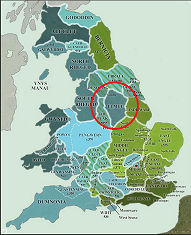 Historically part of the West Riding of Yorkshire, it is one of only three places in the area to be explicitly associated with the ancient Celtic kingdom of Elmet via featuring the kingdom's title in its name, the others being Barwick-in-Elmet and Scholes-in-Elmet.
Historically part of the West Riding of Yorkshire, it is one of only three places in the area to be explicitly associated with the ancient Celtic kingdom of Elmet via featuring the kingdom's title in its name, the others being Barwick-in-Elmet and Scholes-in-Elmet.
During the Civil War two skirmishes took place in Sherburn - first of all in 1642 and then 1645. The latter of these was more significant and resulted in a rout of the Royalist forces commanded by Lord Digby. In the 18th century the new turnpike road along the line of the present A162 brought with it the coaching Inns that served the mail and passenger coaches to and from York. There were services to London, Edinburgh, Sheffield, Newcastle, Selby (connecting to the steam packet) and Scarborough, and at one time there were at least 4 inns serving this trade in Sherburn. One of these was the Red Bear (run by Robert Hough) - which also acted as the meeting place for the local magistrates.
The 19th century brought the Railways and one of the earliest routes from Leeds to Selby in 1834 brought jobs and development to the area. Soon after in 1839 the York and North Midland line created the railway communities at Sherburn station and Milford Junction.
Until early in the twentieth century the village was almost self supporting, not only with grocers, bakers and butchers but with blacksmiths, wheelwrights, tailors, dressmakers and boot and shoe makers.
Sherburn was well known in the nineteenth century for growing teasel for use in the West Riding textile industry.
Julius Falconer's novel "Death by Aloe Seed" is a fictional account of life in Sherburn during this period. The names of his characters were drawn from the parish records of the time.
 Historically part of the West Riding of Yorkshire, it is one of only three places in the area to be explicitly associated with the ancient Celtic kingdom of Elmet via featuring the kingdom's title in its name, the others being Barwick-in-Elmet and Scholes-in-Elmet.
Historically part of the West Riding of Yorkshire, it is one of only three places in the area to be explicitly associated with the ancient Celtic kingdom of Elmet via featuring the kingdom's title in its name, the others being Barwick-in-Elmet and Scholes-in-Elmet. During the Civil War two skirmishes took place in Sherburn - first of all in 1642 and then 1645. The latter of these was more significant and resulted in a rout of the Royalist forces commanded by Lord Digby. In the 18th century the new turnpike road along the line of the present A162 brought with it the coaching Inns that served the mail and passenger coaches to and from York. There were services to London, Edinburgh, Sheffield, Newcastle, Selby (connecting to the steam packet) and Scarborough, and at one time there were at least 4 inns serving this trade in Sherburn. One of these was the Red Bear (run by Robert Hough) - which also acted as the meeting place for the local magistrates.
The 19th century brought the Railways and one of the earliest routes from Leeds to Selby in 1834 brought jobs and development to the area. Soon after in 1839 the York and North Midland line created the railway communities at Sherburn station and Milford Junction.
Until early in the twentieth century the village was almost self supporting, not only with grocers, bakers and butchers but with blacksmiths, wheelwrights, tailors, dressmakers and boot and shoe makers.
Sherburn was well known in the nineteenth century for growing teasel for use in the West Riding textile industry.
Julius Falconer's novel "Death by Aloe Seed" is a fictional account of life in Sherburn during this period. The names of his characters were drawn from the parish records of the time.
1741
Henry Huntriss was born in Sherburn on 27 May 1741 to William and Elisabeth. William, a cordwainer(shoemaker) and Elisabeth were both born in Scarborough and also married there.
1772
Henry marries Mary Varley, daughter of Ingram Varley, farmer, and sister of Ingram Varley junior.
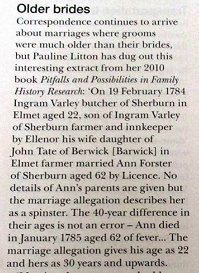
1780
William Huntriss (1780-1847) was born in Sherburn to Henry and Mary.
1787
False allegations.
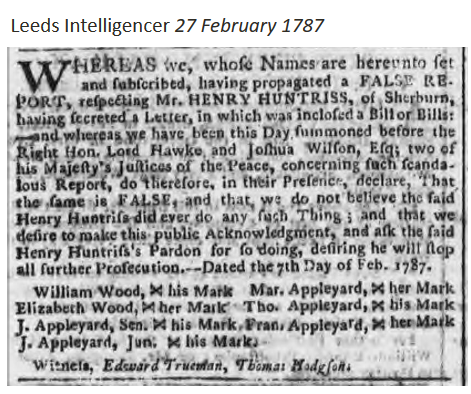
1787
Henry was involved with Sherburn Parish Church.
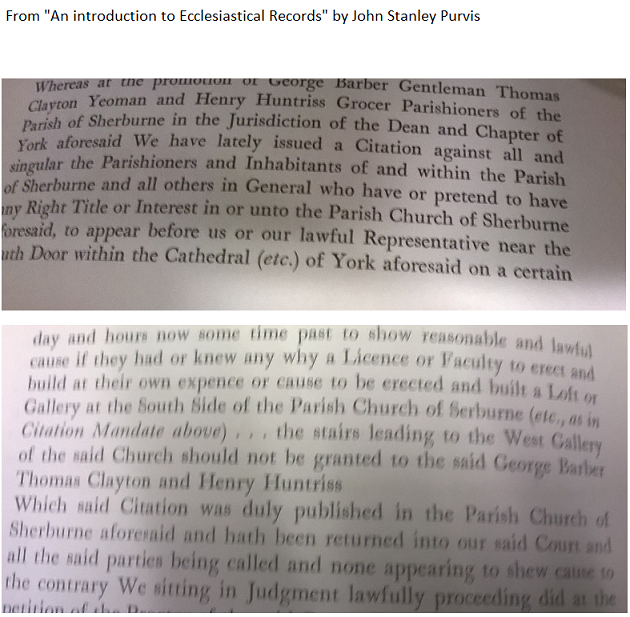
1803
Henry Huntriss takes on an apprentice.

10 October 1806
Henry signs an "Indenture of feoffment" transferring property to a John Wardell. It seems likely that the property had come from his wife's family.
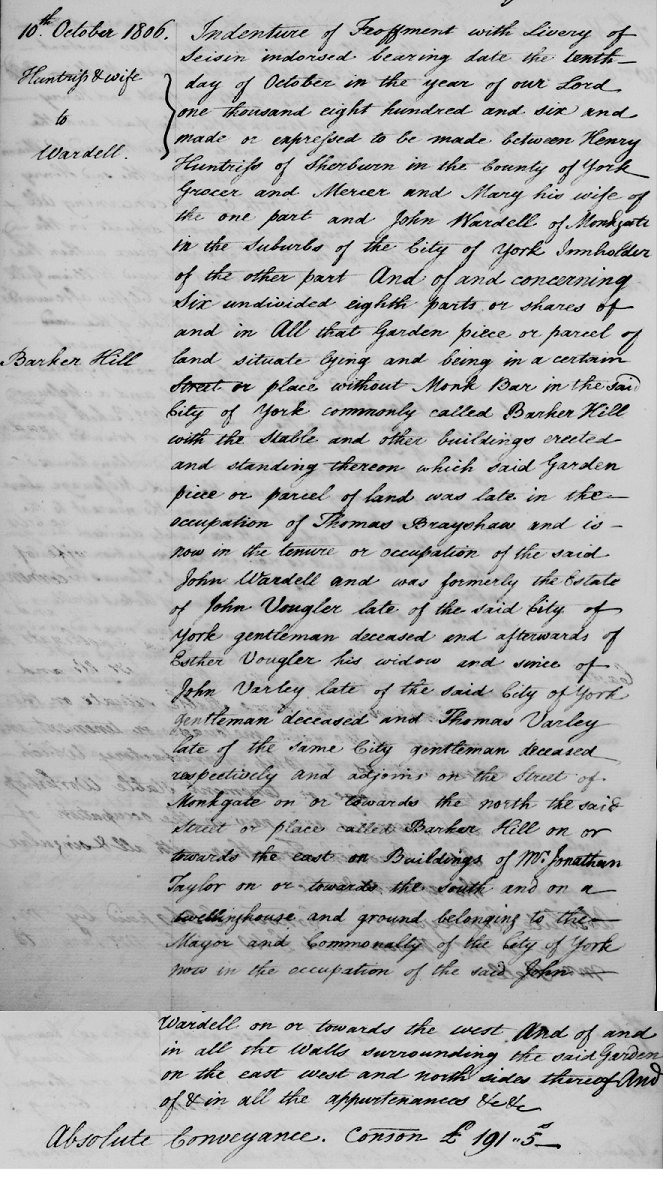
In English law, feoffment was a transfer of land or property that gave the new holder the right to sell it as well as the right to pass it on to his heirs as an inheritance. It was total relinquishment and transfer of all rights of ownership of an estate in land from one individual to another person.
Livery of seisin is an archaic legal conveyancing ceremony, formerly practiced in feudal England and in other countries following English common law, used to convey holdings in property. The term "livery" is related to, if not synonymous with, the word "delivery" as used in modern contract law. The common law in those jurisdictions once provided that a valid conveyance of a feudal tenure in land required the physical transfer by the transferor to the transferee, in the presence of witnesses, of a piece of the ground itself, in the literal sense of a hand-to-hand passing of an amount of soil, a twig, key, or other symbol.
11 October 1806
Henry Huntriss (senior) dies.
1810
Henry(junior) marries Leah Vernon in Liverpool; their children are all born in Neston, Cheshire
1810
William Huntriss has moved to Sowerby Bridge, near Halifax, where he is cotton spinning at the stone mill at Lower Willow Hall Mills.
1819
Notice of Assignment regarding Mary Huntriss.
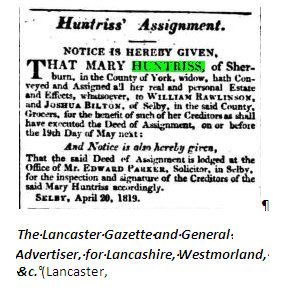
1822
Joseph Huntriss (b1792) listed as Grocer and Draper in the Baines 1822 Directory
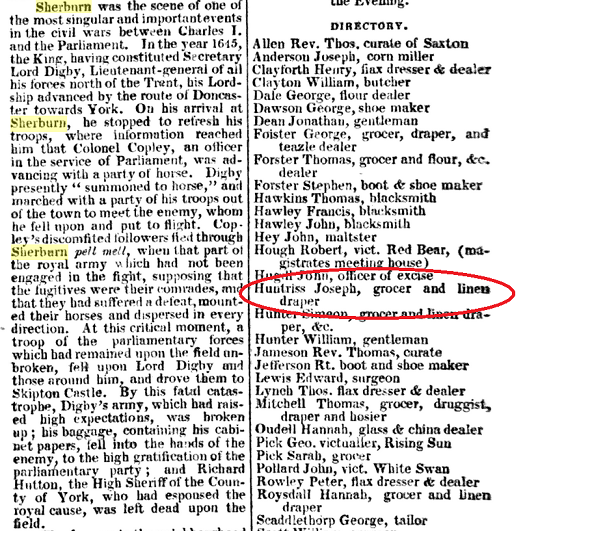
1824
William Huntriss(1780-1847)is declared bankrupt.
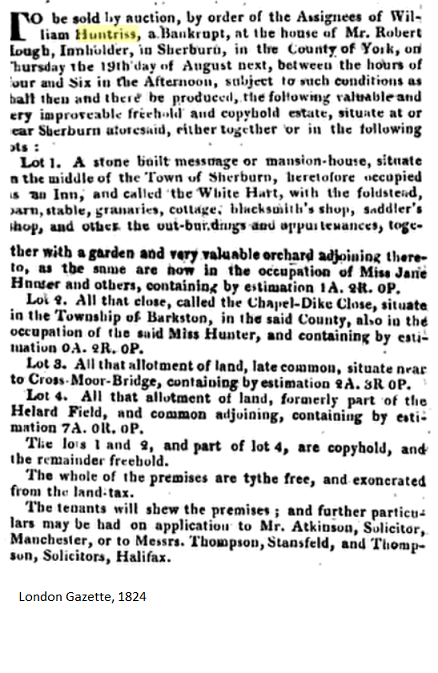
I've not been able to find any other reference to the White Hart inn - it is not listed in the Baines directory of 1822. What is listed is the White Swan inn.
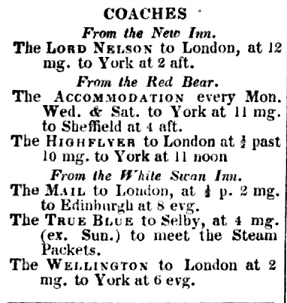
1834
A transcript of Pigot's directory of 1834 shows Mary Huntress (sic) as Grocer and Draper. It is unlikely to have been Henry(senior)'s wife who died the following year aged 86. Perhaps it was Henry (junior)'s granddaughter, born 1811.
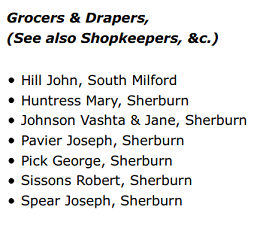
Joseph Huntriss is no longer there - perhaps he had emigrated to America by then.
The snippet below is from the Family Bible once owned by William Huntriss of Halifax, son of William of Sherburn.

1841
The 1841 census shows Elizabeth (Henry and Mary's daughter) living at Low Street in Sherburn, together with John and Elizabeth, children of her brother Henry, who died in 1829, and who lived in Neston, Cheshire.
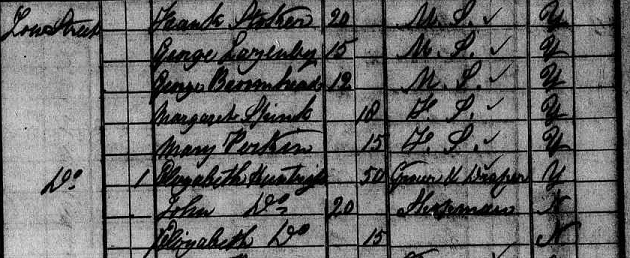
1851
John Huntriss, living in High Street Sherburn, with Elizabeth, his aunt. John's sister Elizabeth married John Dove in 1845

1860
The stock of the Grocers shop is sold
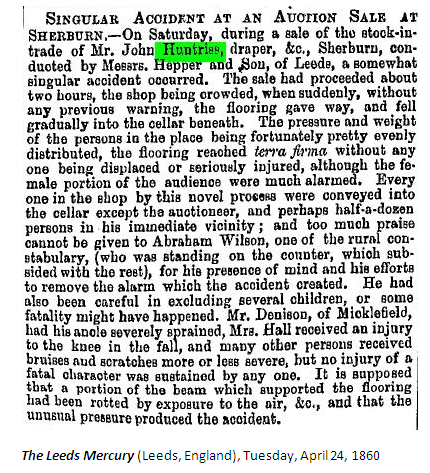
1861
The 1861 census shows John as a visitor, staying with Elias Saynor, Farmer, in Lennerton, Sherburn.
The census records that Mary and five children are living in Workington; the birth of their sixth child, Jane Elizabeth Huntriss, was registered in Cockermouth in 1862.
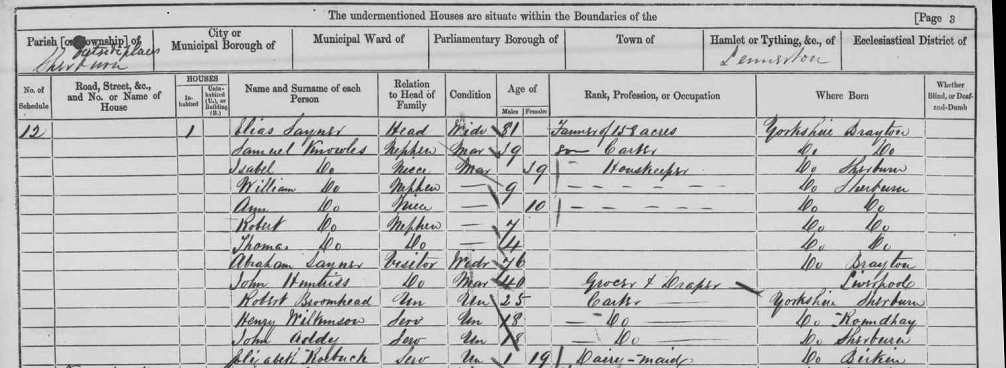
With acknowledgements to the "Memories of Sherburn in Elmet" Facebook group, and the Sherburn in Elmet History Society

1780
William Huntriss (1780-1847) was born in Sherburn to Henry and Mary.
1787
False allegations.

1787
Henry was involved with Sherburn Parish Church.

1803
Henry Huntriss takes on an apprentice.

10 October 1806
Henry signs an "Indenture of feoffment" transferring property to a John Wardell. It seems likely that the property had come from his wife's family.

In English law, feoffment was a transfer of land or property that gave the new holder the right to sell it as well as the right to pass it on to his heirs as an inheritance. It was total relinquishment and transfer of all rights of ownership of an estate in land from one individual to another person.
Livery of seisin is an archaic legal conveyancing ceremony, formerly practiced in feudal England and in other countries following English common law, used to convey holdings in property. The term "livery" is related to, if not synonymous with, the word "delivery" as used in modern contract law. The common law in those jurisdictions once provided that a valid conveyance of a feudal tenure in land required the physical transfer by the transferor to the transferee, in the presence of witnesses, of a piece of the ground itself, in the literal sense of a hand-to-hand passing of an amount of soil, a twig, key, or other symbol.
11 October 1806
Henry Huntriss (senior) dies.
1810
Henry(junior) marries Leah Vernon in Liverpool; their children are all born in Neston, Cheshire
1810
William Huntriss has moved to Sowerby Bridge, near Halifax, where he is cotton spinning at the stone mill at Lower Willow Hall Mills.
1819
Notice of Assignment regarding Mary Huntriss.

1822
Joseph Huntriss (b1792) listed as Grocer and Draper in the Baines 1822 Directory

1824
William Huntriss(1780-1847)is declared bankrupt.

I've not been able to find any other reference to the White Hart inn - it is not listed in the Baines directory of 1822. What is listed is the White Swan inn.

1834
A transcript of Pigot's directory of 1834 shows Mary Huntress (sic) as Grocer and Draper. It is unlikely to have been Henry(senior)'s wife who died the following year aged 86. Perhaps it was Henry (junior)'s granddaughter, born 1811.

Joseph Huntriss is no longer there - perhaps he had emigrated to America by then.
The snippet below is from the Family Bible once owned by William Huntriss of Halifax, son of William of Sherburn.

1841
The 1841 census shows Elizabeth (Henry and Mary's daughter) living at Low Street in Sherburn, together with John and Elizabeth, children of her brother Henry, who died in 1829, and who lived in Neston, Cheshire.

1851
John Huntriss, living in High Street Sherburn, with Elizabeth, his aunt. John's sister Elizabeth married John Dove in 1845

1860
The stock of the Grocers shop is sold

1861
The 1861 census shows John as a visitor, staying with Elias Saynor, Farmer, in Lennerton, Sherburn.
The census records that Mary and five children are living in Workington; the birth of their sixth child, Jane Elizabeth Huntriss, was registered in Cockermouth in 1862.

With acknowledgements to the "Memories of Sherburn in Elmet" Facebook group, and the Sherburn in Elmet History Society

1787
Henry was involved with Sherburn Parish Church.

1803
Henry Huntriss takes on an apprentice.

10 October 1806
Henry signs an "Indenture of feoffment" transferring property to a John Wardell. It seems likely that the property had come from his wife's family.

In English law, feoffment was a transfer of land or property that gave the new holder the right to sell it as well as the right to pass it on to his heirs as an inheritance. It was total relinquishment and transfer of all rights of ownership of an estate in land from one individual to another person.
Livery of seisin is an archaic legal conveyancing ceremony, formerly practiced in feudal England and in other countries following English common law, used to convey holdings in property. The term "livery" is related to, if not synonymous with, the word "delivery" as used in modern contract law. The common law in those jurisdictions once provided that a valid conveyance of a feudal tenure in land required the physical transfer by the transferor to the transferee, in the presence of witnesses, of a piece of the ground itself, in the literal sense of a hand-to-hand passing of an amount of soil, a twig, key, or other symbol.
11 October 1806
Henry Huntriss (senior) dies.
1810
Henry(junior) marries Leah Vernon in Liverpool; their children are all born in Neston, Cheshire
1810
William Huntriss has moved to Sowerby Bridge, near Halifax, where he is cotton spinning at the stone mill at Lower Willow Hall Mills.
1819
Notice of Assignment regarding Mary Huntriss.

1822
Joseph Huntriss (b1792) listed as Grocer and Draper in the Baines 1822 Directory

1824
William Huntriss(1780-1847)is declared bankrupt.

I've not been able to find any other reference to the White Hart inn - it is not listed in the Baines directory of 1822. What is listed is the White Swan inn.

1834
A transcript of Pigot's directory of 1834 shows Mary Huntress (sic) as Grocer and Draper. It is unlikely to have been Henry(senior)'s wife who died the following year aged 86. Perhaps it was Henry (junior)'s granddaughter, born 1811.

Joseph Huntriss is no longer there - perhaps he had emigrated to America by then.
The snippet below is from the Family Bible once owned by William Huntriss of Halifax, son of William of Sherburn.

1841
The 1841 census shows Elizabeth (Henry and Mary's daughter) living at Low Street in Sherburn, together with John and Elizabeth, children of her brother Henry, who died in 1829, and who lived in Neston, Cheshire.

1851
John Huntriss, living in High Street Sherburn, with Elizabeth, his aunt. John's sister Elizabeth married John Dove in 1845

1860
The stock of the Grocers shop is sold

1861
The 1861 census shows John as a visitor, staying with Elias Saynor, Farmer, in Lennerton, Sherburn.
The census records that Mary and five children are living in Workington; the birth of their sixth child, Jane Elizabeth Huntriss, was registered in Cockermouth in 1862.

With acknowledgements to the "Memories of Sherburn in Elmet" Facebook group, and the Sherburn in Elmet History Society
Henry Huntriss takes on an apprentice.

10 October 1806
Henry signs an "Indenture of feoffment" transferring property to a John Wardell. It seems likely that the property had come from his wife's family.

In English law, feoffment was a transfer of land or property that gave the new holder the right to sell it as well as the right to pass it on to his heirs as an inheritance. It was total relinquishment and transfer of all rights of ownership of an estate in land from one individual to another person.
Livery of seisin is an archaic legal conveyancing ceremony, formerly practiced in feudal England and in other countries following English common law, used to convey holdings in property. The term "livery" is related to, if not synonymous with, the word "delivery" as used in modern contract law. The common law in those jurisdictions once provided that a valid conveyance of a feudal tenure in land required the physical transfer by the transferor to the transferee, in the presence of witnesses, of a piece of the ground itself, in the literal sense of a hand-to-hand passing of an amount of soil, a twig, key, or other symbol.
11 October 1806
Henry Huntriss (senior) dies.
1810
Henry(junior) marries Leah Vernon in Liverpool; their children are all born in Neston, Cheshire
1810
William Huntriss has moved to Sowerby Bridge, near Halifax, where he is cotton spinning at the stone mill at Lower Willow Hall Mills.
1819
Notice of Assignment regarding Mary Huntriss.

1822
Joseph Huntriss (b1792) listed as Grocer and Draper in the Baines 1822 Directory

1824
William Huntriss(1780-1847)is declared bankrupt.

I've not been able to find any other reference to the White Hart inn - it is not listed in the Baines directory of 1822. What is listed is the White Swan inn.

1834
A transcript of Pigot's directory of 1834 shows Mary Huntress (sic) as Grocer and Draper. It is unlikely to have been Henry(senior)'s wife who died the following year aged 86. Perhaps it was Henry (junior)'s granddaughter, born 1811.

Joseph Huntriss is no longer there - perhaps he had emigrated to America by then.
The snippet below is from the Family Bible once owned by William Huntriss of Halifax, son of William of Sherburn.

1841
The 1841 census shows Elizabeth (Henry and Mary's daughter) living at Low Street in Sherburn, together with John and Elizabeth, children of her brother Henry, who died in 1829, and who lived in Neston, Cheshire.

1851
John Huntriss, living in High Street Sherburn, with Elizabeth, his aunt. John's sister Elizabeth married John Dove in 1845

1860
The stock of the Grocers shop is sold

1861
The 1861 census shows John as a visitor, staying with Elias Saynor, Farmer, in Lennerton, Sherburn.
The census records that Mary and five children are living in Workington; the birth of their sixth child, Jane Elizabeth Huntriss, was registered in Cockermouth in 1862.

With acknowledgements to the "Memories of Sherburn in Elmet" Facebook group, and the Sherburn in Elmet History Society
11 October 1806
Henry Huntriss (senior) dies.
1810
Henry(junior) marries Leah Vernon in Liverpool; their children are all born in Neston, Cheshire
1810
William Huntriss has moved to Sowerby Bridge, near Halifax, where he is cotton spinning at the stone mill at Lower Willow Hall Mills.
1819
Notice of Assignment regarding Mary Huntriss.

1822
Joseph Huntriss (b1792) listed as Grocer and Draper in the Baines 1822 Directory

1824
William Huntriss(1780-1847)is declared bankrupt.

I've not been able to find any other reference to the White Hart inn - it is not listed in the Baines directory of 1822. What is listed is the White Swan inn.

1834
A transcript of Pigot's directory of 1834 shows Mary Huntress (sic) as Grocer and Draper. It is unlikely to have been Henry(senior)'s wife who died the following year aged 86. Perhaps it was Henry (junior)'s granddaughter, born 1811.

Joseph Huntriss is no longer there - perhaps he had emigrated to America by then.
The snippet below is from the Family Bible once owned by William Huntriss of Halifax, son of William of Sherburn.

1841
The 1841 census shows Elizabeth (Henry and Mary's daughter) living at Low Street in Sherburn, together with John and Elizabeth, children of her brother Henry, who died in 1829, and who lived in Neston, Cheshire.

1851
John Huntriss, living in High Street Sherburn, with Elizabeth, his aunt. John's sister Elizabeth married John Dove in 1845

1860
The stock of the Grocers shop is sold

1861
The 1861 census shows John as a visitor, staying with Elias Saynor, Farmer, in Lennerton, Sherburn.
The census records that Mary and five children are living in Workington; the birth of their sixth child, Jane Elizabeth Huntriss, was registered in Cockermouth in 1862.

1810
William Huntriss has moved to Sowerby Bridge, near Halifax, where he is cotton spinning at the stone mill at Lower Willow Hall Mills.
1819
Notice of Assignment regarding Mary Huntriss.

1822
Joseph Huntriss (b1792) listed as Grocer and Draper in the Baines 1822 Directory

1824
William Huntriss(1780-1847)is declared bankrupt.

I've not been able to find any other reference to the White Hart inn - it is not listed in the Baines directory of 1822. What is listed is the White Swan inn.

1834
A transcript of Pigot's directory of 1834 shows Mary Huntress (sic) as Grocer and Draper. It is unlikely to have been Henry(senior)'s wife who died the following year aged 86. Perhaps it was Henry (junior)'s granddaughter, born 1811.

Joseph Huntriss is no longer there - perhaps he had emigrated to America by then.
The snippet below is from the Family Bible once owned by William Huntriss of Halifax, son of William of Sherburn.

1841
The 1841 census shows Elizabeth (Henry and Mary's daughter) living at Low Street in Sherburn, together with John and Elizabeth, children of her brother Henry, who died in 1829, and who lived in Neston, Cheshire.

1851
John Huntriss, living in High Street Sherburn, with Elizabeth, his aunt. John's sister Elizabeth married John Dove in 1845

1860
The stock of the Grocers shop is sold

1861
The 1861 census shows John as a visitor, staying with Elias Saynor, Farmer, in Lennerton, Sherburn.
The census records that Mary and five children are living in Workington; the birth of their sixth child, Jane Elizabeth Huntriss, was registered in Cockermouth in 1862.

Notice of Assignment regarding Mary Huntriss.

1822
Joseph Huntriss (b1792) listed as Grocer and Draper in the Baines 1822 Directory

1824
William Huntriss(1780-1847)is declared bankrupt.

I've not been able to find any other reference to the White Hart inn - it is not listed in the Baines directory of 1822. What is listed is the White Swan inn.

1834
A transcript of Pigot's directory of 1834 shows Mary Huntress (sic) as Grocer and Draper. It is unlikely to have been Henry(senior)'s wife who died the following year aged 86. Perhaps it was Henry (junior)'s granddaughter, born 1811.

Joseph Huntriss is no longer there - perhaps he had emigrated to America by then.
The snippet below is from the Family Bible once owned by William Huntriss of Halifax, son of William of Sherburn.

1841
The 1841 census shows Elizabeth (Henry and Mary's daughter) living at Low Street in Sherburn, together with John and Elizabeth, children of her brother Henry, who died in 1829, and who lived in Neston, Cheshire.

1851
John Huntriss, living in High Street Sherburn, with Elizabeth, his aunt. John's sister Elizabeth married John Dove in 1845

1860
The stock of the Grocers shop is sold

1861
The 1861 census shows John as a visitor, staying with Elias Saynor, Farmer, in Lennerton, Sherburn.
The census records that Mary and five children are living in Workington; the birth of their sixth child, Jane Elizabeth Huntriss, was registered in Cockermouth in 1862.

William Huntriss(1780-1847)is declared bankrupt.

I've not been able to find any other reference to the White Hart inn - it is not listed in the Baines directory of 1822. What is listed is the White Swan inn.

1834
A transcript of Pigot's directory of 1834 shows Mary Huntress (sic) as Grocer and Draper. It is unlikely to have been Henry(senior)'s wife who died the following year aged 86. Perhaps it was Henry (junior)'s granddaughter, born 1811.

Joseph Huntriss is no longer there - perhaps he had emigrated to America by then.
The snippet below is from the Family Bible once owned by William Huntriss of Halifax, son of William of Sherburn.

1841
The 1841 census shows Elizabeth (Henry and Mary's daughter) living at Low Street in Sherburn, together with John and Elizabeth, children of her brother Henry, who died in 1829, and who lived in Neston, Cheshire.

1851
John Huntriss, living in High Street Sherburn, with Elizabeth, his aunt. John's sister Elizabeth married John Dove in 1845

1860
The stock of the Grocers shop is sold

1861
The 1861 census shows John as a visitor, staying with Elias Saynor, Farmer, in Lennerton, Sherburn.
The census records that Mary and five children are living in Workington; the birth of their sixth child, Jane Elizabeth Huntriss, was registered in Cockermouth in 1862.


1851
John Huntriss, living in High Street Sherburn, with Elizabeth, his aunt. John's sister Elizabeth married John Dove in 1845

1860
The stock of the Grocers shop is sold

1861
The 1861 census shows John as a visitor, staying with Elias Saynor, Farmer, in Lennerton, Sherburn.
The census records that Mary and five children are living in Workington; the birth of their sixth child, Jane Elizabeth Huntriss, was registered in Cockermouth in 1862.


1861
The 1861 census shows John as a visitor, staying with Elias Saynor, Farmer, in Lennerton, Sherburn.
The census records that Mary and five children are living in Workington; the birth of their sixth child, Jane Elizabeth Huntriss, was registered in Cockermouth in 1862.

With acknowledgements to the "Memories of Sherburn in Elmet" Facebook group, and the Sherburn in Elmet History Society


